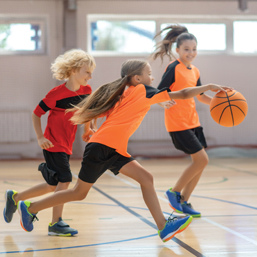
You’ve probably heard the term “healthy competition” before. When compared to unhealthy competition, of course, we want our children engaged in the good side of it! But as a parent, do you know the signs of healthy versus unhealthy competition? Selecting sports and activities for children is a daunting exercise, and can be marked with your own personal experiences from your youth. But there are key components of competition that will create a sporting environment where your child will develop their skills and have fun.
Ask your child why they want to participate. Their answers could be to have fun, to play with my friends, and maybe even to win! Competition and winning can be a powerful motivator for children. However, if competing and winning is the focus of the program, it may be at the expense of skill development, health of the participant, enjoyment, and ultimately the child’s motivation to continue. We know that children who have fun playing a sport are more likely to see it as a positive experience and are more likely to stay active throughout their lives.
The Canadian Sport for Life framework identifies that children will participate in sport and stay in sport if they do the right things at the right times. This means that before approximately 8 or 9 years old, competition should be informal, with no record of results. The next stage (up to when children reach the adolescent growth spurt) is local competition, where children can compete or play in different events or in different positions. When children are in that adolescent growth spurt (approximately eleven to sixteen), it’s developmentally appropriate to participate in formal competition with standings or rankings.
Overall, participants need to train not only in sport-specific skills, but also in overall fitness and strength. This will help prevent injury and burnout. All sport and activity experiences need to serve the needs of the participant.
At every age and stage, healthy competition is designed to support what has been practiced or trained. Games or competitions should be “right-sized,” including the game space (for example, the size of the field or course) and the equipment (for example, size of jumps, or height of nets). Participants competing against each other should be equally matched, resulting in close competition and avoiding big losses.
Before registering your child for an activity, ask the organization how their programming supports healthy competition. A quality sport organization will be able to provide a comprehensive plan for the program that outlines the steps of skill development, training, and competition. Most importantly, have a conversation with your child about why they want to play. Motivation is different for every child, and will change as they age and progress, so understanding what they value is important.
Keely believes learning from play builds empathy, understanding, a desire to see other perspectives, and ultimately, makes for better world citizens. She has promoted these values in her role as a WordPLAY Consultant, HIGH FIVE®, NCCP and as a Healthy Play Trainer for the last ten years. Need to create more connections across your education, sport, or recreation organization? Visit wordplaycanada.com. Feeling Social? Follow on Instagram @wordplaycanada.
Calgary’s Child Magazine © 2024 Calgary’s Child